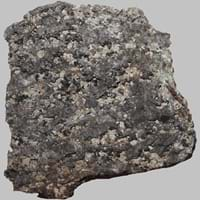Definition
Oolite is a sedimentary rock formed from ooids, spherical grains which are composed of concentric layers of calcite
Essexite which is also known as nepheline monzogabbro, is a dark gray or black holocrystalline plutonic Iigneous Rock
Discoverer
Unknown
Unknown
Etymology
From oo- + -lite, after German Oolit. A rock consisting of fine grains of carbonate of lime
From the locality in Essex County, Massachusetts,US
Class
Sedimentary Rocks
Igneous Rocks
Sub-Class
Durable Rock, Medium Hardness Rock
Durable Rock, Hard Rock
Other Categories
Fine Grained Rock, Opaque Rock
Fine Grained Rock, Opaque Rock
Texture
Clastic or Non-Clastic
Granular
Color
Black, Blue, Brown, Cream, Green, Grey, Pink, Red, Silver, White, Yellow
Dark Grey to Black
Durability
Durable
Durable
Scratch Resistant
Yes
Yes
Appearance
Rounded and Rough
Banded
Interior Uses
Decorative Aggregates, Flooring, Interior Decoration
Decorative Aggregates, Homes, Interior Decoration
Exterior Uses
As Building Stone, As Facing Stone, Garden Decoration, Paving Stone
As Building Stone, As Facing Stone, Garden Decoration, Office Buildings, Paving Stone
Other Architectural Uses
Not Yet Used
Curbing
Construction Industry
Cement Manufacture, Cobblestones, Landscaping
As Dimension Stone, Building houses or walls, Cement Manufacture, Construction Aggregate, for Road Aggregate
Medical Industry
Not Yet Used
Not Yet Used
Antiquity Uses
Artifacts
Artifacts, Monuments, Sculpture, Small Figurines
Commercial Uses
Creating Artwork, Jewelry, Used in aquariums
Cemetery Markers, Commemorative Tablets, Jewelry, Sea Defence, Tombstones
Types
Not Available
Not Available
Features
Available in lots of colors, Generally rough to touch, Very fine grained rock
Is one of the oldest rock, Smooth to touch
Archaeological Significance
Monuments
Not Yet Used
Used
Famous Monuments
Not Applicable
Data Not Available
Sculpture
Not Yet Used
Used
Famous Sculptures
Not Applicable
Data Not Available
Pictographs
Used
Not Used
Petroglyphs
Used
Not Used
Figurines
Not Yet Used
Used
Formation
Oolites form when layers of calcite are deposited around a sand grain or fossil piece and are rolled around in calm water, which makes them round.
Essexite is a type of igneous rock, which is usually dark grey to black plutonic rock. For the formation of essexite, suitable magma with exact composition of K, Ba, Rb, Cs, Sr should be produced.
Mineral Content
Calcite, Chert, Clay, Dolomite, Quartz, Sand, Silt
Augite, Feldspar, Hornblende, Nepheline, Olivine, Plagioclase, Pyroxene
Compound Content
Aluminium Oxide, Ca, NaCl, CaO, Iron(III) Oxide, FeO, MgO
Aluminium Oxide, Ba, Ca, Cs, Potassium, Rb, Sodium, Sr
Types of Metamorphism
Not Applicable
Burial Metamorphism, Cataclastic Metamorphism, Contact Metamorphism, Hydrothermal Metamorphism, Impact Metamorphism
Types of Weathering
Biological Weathering, Chemical Weathering, Mechanical Weathering
Biological Weathering, Chemical Weathering
Types of Erosion
Chemical Erosion, Coastal Erosion
Coastal Erosion, Glacier Erosion, Water Erosion
Grain Size
Fine Grained
Fine Grained
Fracture
Conchoidal
Conchoidal
Porosity
Less Porous
Highly Porous
Luster
Pearly to Shiny
Not Available
Cleavage
Non-Existent
Not Available
Specific Gravity
Not Available
Not Available
Transparency
Opaque
Opaque
Density
Not Available
Not Available
Resistance
Heat Resistant, Wear Resistant
Impact Resistant, Pressure Resistant, Wear Resistant
Deposits in Eastern Continents
Asia
Brunei, India, Indonesia, Malaysia, Singapore, Thailand, Vietnam
India, Russia
Africa
Cameroon, Chad, Ghana, Kenya, Malawi, Sudan, Tanzania, Togo, Zambia, Zimbabwe
South Africa
Europe
United Kingdom
Germany, Greece, Italy, Scotland, Turkey
Others
Not Yet Found
Greenland
Deposits in Western Continents
North America
USA
Canada, USA
South America
Colombia
Brazil, Colombia, Venezuela
Deposits in Oceania Continent
Australia
Adelaide, New Zealand, Queensland, Tonga, Victoria, Yorke Peninsula
New Zealand, Queensland
Oolite vs Essexite Characteristics
Though some rocks look identical, they have certain characteristics which distinguish them from others. Characteristics of rocks include texture, appearance, color, fracture, streak, hardness etc. Oolite vs Essexite characteristics assist us to distinguish and recognize rocks. Also you can check about Properties of Oolite and Properties of Essexite . Learn more about Oolite vs Essexite in the next section. The interior uses of Oolite include Decorative aggregates, Flooring and Interior decoration whereas the interior uses of Essexite include Decorative aggregates, Homes and Interior decoration. Due to some exceptional properties of Oolite and Essexite , they have various applications in construction industry. The uses of Oolite in construction industry include Cement manufacture, Cobblestones, Landscaping and that of Essexite include As dimension stone, Building houses or walls, Cement manufacture, Construction aggregate, For road aggregate.
More about Oolite and Essexite
Here you can know more about Oolite and Essexite . The life cycle of a rock consists of formation of rock, composition of rock and transformation of rock. The composition of Oolite and Essexite consists of mineral content and compound content. The mineral content of Oolite includes Calcite, Chert, Clay, Dolomite, Quartz, Sand, Silt and mineral content of Essexite includes Augite, Feldspar, Hornblende, Nepheline, Olivine, Plagioclase, Pyroxene. You can also check out the list of all Sedimentary Rocks. When we have to compare Oolite vs Essexite , the texture, color and appearance plays an important role in determining the type of rock. Oolite is available in black, blue, brown, cream, green, grey, pink, red, silver, white, yellow colors whereas, Essexite is available in dark grey to black colors. Appearance of Oolite is Rounded and Rough and that of Essexite is Banded. Properties of rock is another aspect for Oolite vs Essexite . The hardness of Oolite is 3-4 and that of Essexite is 7. The types of Oolite are Not Available whereas types of Essexite are Not Available. Streak of rock is the color of powder produced when it is dragged across an unweathered surface. The streak of Oolite is white while that of Essexite is black. The specific heat capacity of Oolite is Not Available and that of Essexite is Not Available. Depending on the properties like hardness, toughness, specific heat capacity, porosity etc., rocks are resistant to heat, wear, impact, etc.Oolite is heat resistant, wear resistant whereas Essexite is impact resistant, pressure resistant, wear resistant.





